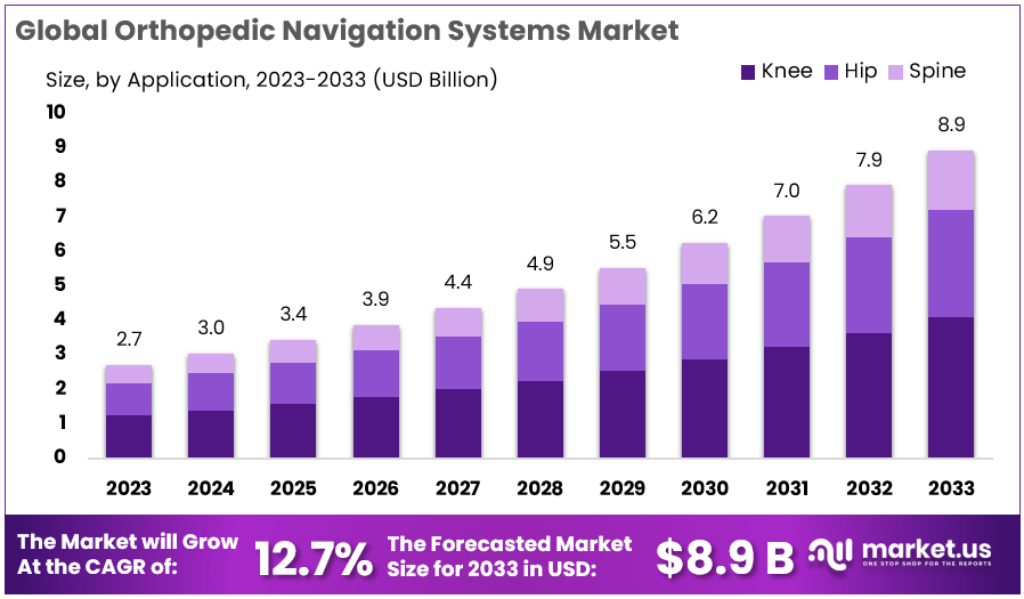Table of Contents
Introduction
The global Orthopedic Navigation Systems Market is projected to expand from USD 2.7 billion in 2023 to USD 8.9 billion by 2033, growing at a compound annual growth rate (CAGR) of 12.7%. This growth is fueled by the increasing demand for precision in surgical procedures, which these systems significantly enhance. By guiding surgical instruments in real-time, these systems reduce surgical risks and improve patient outcomes, promoting wider adoption across healthcare settings.
Technological advancements also significantly influence market growth. Innovations such as 3D imaging and robotic assistance are being integrated into orthopedic navigation systems, improving surgeons’ control and visualization during operations. This integration not only enhances the effectiveness of surgeries but also minimizes the duration of both surgery and patient recovery, thus optimizing healthcare resources.
Additionally, there is a shift towards standardizing surgical procedures and equipment to minimize variability in patient outcomes. This standardization, supported by clinical guidelines, aims to reduce complications and enhance the safety and quality of healthcare services. Such initiatives are particularly vital in orthopedics where precision is key to successful outcomes.
Moreover, the market is experiencing a trend towards outpatient orthopedic procedures that require highly accurate and efficient navigation systems. This shift, driven by economic benefits and the need for quick surgical turnarounds, supports healthcare cost containment strategies. As a result, the sector is poised for substantial growth as it continues to offer high-quality, efficient, and cost-effective solutions that improve patient care and operational efficiencies.

Key Takeaways
- The market for Orthopedic Navigation Systems is projected to surge from USD 2.7 billion in 2023 to USD 8.9 billion by 2033, growing at a 12.7% CAGR.
- In 2023, Knee navigation systems dominate the market, capturing 45.9% share due to the increasing number of knee replacement surgeries.
- Hospitals are the leading end-users, holding a 56.2% market share in 2023, supported by their extensive medical facilities.
- North America is the market leader with a 45.1% share in 2023, propelled by its sophisticated healthcare infrastructure and heightened awareness.
- The Asia Pacific region is poised for the highest growth, with a 13.7% CAGR, driven by unmet medical needs and government initiatives.
- Major players like Stryker, Zimmer Biomet, Smith & Nephew, Medtronic, and NuVasive control over 60% of the market share collectively.
Use Cases
- Joint Replacement Surgery: These systems play a critical role in joint replacement procedures by ensuring the precise placement and alignment of implants. Accurate implant positioning is essential for the implant’s long-term functionality and stability, significantly reducing the likelihood of needing revision surgeries.
- Spine Surgery: In the realm of spine surgery, navigation systems are indispensable for the exact placement of pedicle screws. These screws are vital for successful spinal fusions and correcting deformities, particularly in complex anatomical areas.
- Orthopedic Trauma Surgery: Navigation technology is crucial in trauma-related surgeries, where it enhances fracture management. By ensuring implants are perfectly aligned and fit, these systems support better healing and functional recovery.
- Sports Medicine: In sports medicine, orthopedic navigation aids in procedures like ligament reconstructions by ensuring accurate tunnel placement. This precision optimizes graft fixation, enhancing surgical outcomes for athletes.
- Minimally Invasive Surgery: These systems provide real-time feedback and detailed visualizations, enabling surgeons to perform procedures with smaller incisions. This leads to less tissue damage, reduced pain, quicker recovery, and shorter hospital stays.
- Educational and Training Tool: Orthopedic navigation systems also serve as educational tools that allow surgeons to simulate surgeries and visualize the impact of their surgical decisions in real-time. This feature is invaluable for training and improving the skills of new surgeons.
- Enhanced Safety and Reduced Complications: By facilitating accurate implant placement and minimizing intraoperative radiation exposure, these systems also significantly reduce the risk of surgical complications.
Regional Analysis
North America retains a strong lead in the Orthopedic Navigation Systems Market, holding 45.1% of the market with a value of USD 1.21 billion in 2023. The region’s dominance is supported by its advanced healthcare facilities and widespread awareness of orthopedic navigation technologies. Factors such as an aging population, high healthcare expenditure by the government, and a comprehensive reimbursement framework are key contributors to its market leadership.
The presence of numerous established manufacturers enhances North America’s market position. Collaborative efforts between government entities like the American Board of Orthopedic Surgeries and educational institutions are enriching skill-based training. These initiatives are vital for fostering growth in the orthopedic navigation systems sector.
In contrast, the Asia Pacific region is poised for rapid expansion, expected to grow at a CAGR of 13.7%. This growth is driven by unmet clinical needs, governmental efforts to promote awareness of minimally invasive procedures, and strategic investments by manufacturers in cost-effective technologies.
Take advantage of our unbeatable offer - buy now!

The large elderly population in countries such as China, Japan, and India offers a substantial market opportunity. Notable developments, like Exactech’s expansion of its Newton knee technique in May 2023, underscore the increasing significance of the Asia Pacific market in the global orthopedic navigation systems landscape. This indicates a strong future demand in the region.
Conclusion
In conclusion, the global market for Orthopedic Navigation Systems is poised for substantial growth, primarily driven by advancements in technology and an increasing emphasis on precision and safety in surgical procedures. These systems are becoming indispensable in various orthopedic applications, from joint replacements to spine surgeries, enhancing outcomes and reducing surgical risks. The market is also benefiting from trends towards outpatient procedures and standardization of surgical practices. With North America leading in market share and the Asia Pacific region showing the fastest growth, the future of orthopedic navigation systems looks promising as they continue to evolve into essential tools for modern orthopedic care.
Discuss your needs with our analyst
Please share your requirements with more details so our analyst can check if they can solve your problem(s)



